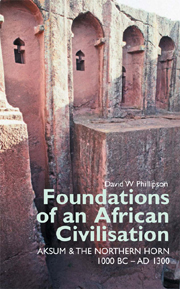Book contents
- Frontmatter
- Contents
- List of illustrations
- 1 General introduction
- Part One BEFORE AKSUM
- Part Two THE KINGDOM OF AKSUM
- 4 Aksumite civilisation: an introductory summary
- 5 Aksumite languages and literacy
- 6 Some written sources relating to Aksumite civilisation
- 7 The emergence and expansion of the Aksumite state
- 8 Aksumite kingship and politics
- 9 Aksumite religion
- 10 Cultivation and herding, food and drink
- 11 Urbanism, architecture and non-funerary monuments
- 12 Aksumite burials
- 13 Aksumite technology and material culture
- 14 Aksumite coinage
- 15 Foreign contacts of the Aksumite state
- 16 Decline and transformation of the Aksumite state
- Part Three AFTER AKSUM
- Bibliographic references
- Index
- EASTERN AFRICAN STUDIES
8 - Aksumite kingship and politics
from Part Two - THE KINGDOM OF AKSUM
Published online by Cambridge University Press: 05 December 2015
- Frontmatter
- Contents
- List of illustrations
- 1 General introduction
- Part One BEFORE AKSUM
- Part Two THE KINGDOM OF AKSUM
- 4 Aksumite civilisation: an introductory summary
- 5 Aksumite languages and literacy
- 6 Some written sources relating to Aksumite civilisation
- 7 The emergence and expansion of the Aksumite state
- 8 Aksumite kingship and politics
- 9 Aksumite religion
- 10 Cultivation and herding, food and drink
- 11 Urbanism, architecture and non-funerary monuments
- 12 Aksumite burials
- 13 Aksumite technology and material culture
- 14 Aksumite coinage
- 15 Foreign contacts of the Aksumite state
- 16 Decline and transformation of the Aksumite state
- Part Three AFTER AKSUM
- Bibliographic references
- Index
- EASTERN AFRICAN STUDIES
Summary
Since much of our information about Aksumite politics is derived from what was essentially royal propaganda, it is not surprising – although nonetheless unfortunate – that we know very little about the lower levels of administration.
The king
There can be no reasonable doubt that the prime authority in the Aksumite state was that of the king. For reasons set out in Chapter 7, the hypothesis that the Zoscales mentioned in the Periplus of the Erythraean Sea was a first-century king of Aksum is not accepted here. The earliest incontrovertible and dateable mention of an Aksumite king dates about 150 years later and occurs, not at Aksum itself, but on an inscribed copper-alloy object (Fig. 23) found in a cache at Addi Gelamo in the eastern highlands of Tigray. The inscription (RIE 180), which seems to have been incised into the object after it had been cast, is in Ge'ez, using an early form of unvocalised Ethiopic script read from left to right; it mentions GDR NGSY KSM [= GDR, king of Aksum]. Note that, at this early period, the king of Aksum already bore the title negus (cf. below). It is tempting, but not wholly convincing, to equate this individual with an Aksumite ruler called GDRT, known from inscriptions in southern Arabia of roughly the same period. Southern Arabian inscriptions name three further individuals as kings of Aksum, but give no indication that they exercised political control – as opposed to more transitory influence – over Arabian territory.
- Type
- Chapter
- Information
- Foundations of an African CivilisationAksum and the northern Horn, 1000 BC - AD 1300, pp. 79 - 90Publisher: Boydell & BrewerPrint publication year: 2012



